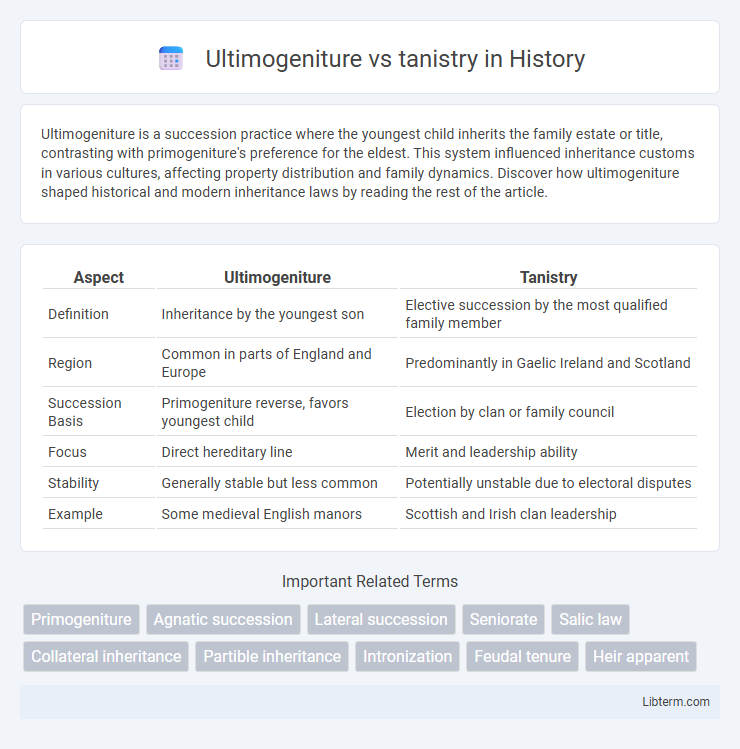Ultimogeniture is a succession practice where the youngest child inherits the family estate or title, contrasting with primogeniture's preference for the eldest. This system influenced inheritance customs in various cultures, affecting property distribution and family dynamics. Discover how ultimogeniture shaped historical and modern inheritance laws by reading the rest of the article.
Table of Comparison
| Aspect | Ultimogeniture | Tanistry |
|---|---|---|
| Definition | Inheritance by the youngest son | Elective succession by the most qualified family member |
| Region | Common in parts of England and Europe | Predominantly in Gaelic Ireland and Scotland |
| Succession Basis | Primogeniture reverse, favors youngest child | Election by clan or family council |
| Focus | Direct hereditary line | Merit and leadership ability |
| Stability | Generally stable but less common | Potentially unstable due to electoral disputes |
| Example | Some medieval English manors | Scottish and Irish clan leadership |
Introduction to Inheritance Systems
Ultimogeniture is an inheritance system where the youngest child inherits the family estate, contrasting sharply with tanistry, which is a Gaelic practice of electing the most capable male relative to succeed leadership rather than following strict birth order. Ultimogeniture emphasizes primacy of the last-born offspring, often to maintain family continuity and property within the immediate lineage. Tanistry prioritizes merit and consensus among clan members, influencing succession in early Irish and Scottish cultures by combining hereditary right with elective principles.
Defining Ultimogeniture
Ultimogeniture is a form of inheritance where the youngest child inherits the family estate or title, differing significantly from primogeniture and tanistry. Unlike tanistry, which selects leaders based on merit or election within a family or clan, ultimogeniture follows a strict birth order rule favoring the last-born descendant. This inheritance practice was historically prevalent in certain rural societies, ensuring that the youngest child retained familial lands and responsibilities.
Understanding Tanistry
Tanistry is a Gaelic succession system where the heir, called the tanist, is elected from the ruling family based on merit and ability rather than strict birth order, contrasting sharply with ultimogeniture, which grants inheritance to the youngest child. Tanistry emphasizes leadership qualities and consensus among clan elders, aiming to ensure the most capable individual governs. This elective approach often led to dynamic but sometimes unstable successions, reflecting the clan's priorities in maintaining strong leadership over rigid hereditary rules.
Historical Origins of Ultimogeniture
Ultimogeniture, a system where the youngest child inherits the estate, traces its historical origins to medieval Europe, particularly in regions like England and parts of Germany. This inheritance practice was often employed to keep land intact within a family, especially in agrarian societies where younger sons stayed home to care for aging parents and maintain the family farm. Unlike tanistry, which was practiced mainly in Gaelic societies and involved elected succession among eligible males, ultimogeniture focused on birth order as the determinant of inheritance rights.
Historical Roots of Tanistry
Tanistry, rooted in Celtic traditions, established a succession system where leadership was elected from among eligible males of the ruling family, emphasizing merit and ability over strict birth order. Unlike ultimogeniture, which grants inheritance to the youngest child, tanistry aimed to ensure capable governance by selecting the most suitable heir during the current leader's lifetime. This method was prominent in early Irish and Scottish clans, reflecting a flexible and pragmatic approach to hereditary leadership.
Key Differences Between Ultimogeniture and Tanistry
Ultimogeniture is a hereditary succession system where the youngest child inherits the estate, emphasizing a linear and predictable transfer of property, while tanistry involves the selection of a successor from among the eligible male kin, prioritizing merit and leadership qualities over birth order. Unlike ultimatogeniture's automatic inheritance by birthright, tanistry relies on clan consensus or election to determine the tanist, reflecting more fluid political dynamics. These contrasting mechanisms illustrate the differing cultural and social priorities in property inheritance and leadership succession within various historical contexts.
Social and Political Impacts
Ultimogeniture, favoring the youngest son, often stabilized social hierarchies by minimizing sibling rivalry and preserving estate integrity, leading to consistent local governance. Tanistry, involving elective succession among a broader kin group, fostered dynamic political alliances and flexible leadership but frequently caused power struggles and factionalism within clans. These succession systems shaped governance structures, influencing both social cohesion and political stability in medieval societies.
Case Studies: Ultimogeniture in Practice
Ultimogeniture, a succession practice favoring the youngest son, was notably prevalent in parts of England and Germany, where it ensured estates remained intact and support was provided to younger siblings. In Dorset, England, historical land records reveal how ultimoniture shaped inheritance patterns by preventing estate fragmentation and fostering familial stability. Contrastingly, tanistry, common in Gaelic Scotland and Ireland, selected rulers based on merit and consensus rather than birth order, emphasizing leadership qualities over age in clan succession.
Case Studies: Tanistry in Practice
Tanistry, a succession system historically used in Gaelic Ireland and Scotland, prioritized electing a capable leader from the derbfine, often favoring merit over direct lineage, contrasting sharply with ultimogeniture which granted inheritance to the youngest child. Notable case studies include the O'Neill dynasty in Ulster, where tanistry led to periodic leadership disputes but ensured rulers with military and political prowess. This practice balanced clan stability and adaptability, unlike ultimogeniture's straightforward but rigid succession favoring the last-born heir.
Modern Relevance and Legacy
Ultimogeniture, favoring the youngest child's inheritance, persists in some modern rural societies, influencing land succession and family dynamics, while tanistry's elective succession shaped early Scottish and Irish politics but holds minimal legal standing today. Both systems contribute to anthropological and legal studies on inheritance diversity, offering insight into non-primogeniture traditions. Their legacies endure in cultural narratives and customary law, underscoring varying approaches to leadership and property transfer across history.
Ultimogeniture Infographic

 libterm.com
libterm.com